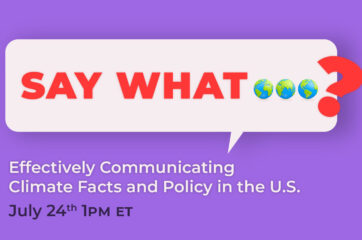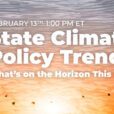Including equity in climate action is of the utmost importance, but many climate policy actors may be unsure of how exactly to do so in their climate programs. With the influx of federal climate funding initiatives and the ever-increasing pressure of climate change on our communities, we must take steps to design and implement truly justice-centered climate programs. Fortunately, we can learn from existing examples across the country; at the state and local level, governments have been partnering with communities to create innovative, equity-based outcomes for years, and we must look to them when designing new climate funding programs or altering existing ones.
We were joined by representatives from two such examples of climate equity programs: Sophie Young, Program Manager for the Transformative Climate Communities Program at California’s Strategic Growth Council, and Sam Baraso, Program Manager for the Portland Clean Energy Community Benefits Fund at the City of Portland’s Bureau of Planning & Sustainability. We discussed what operationalizing equity looks like, the importance of community engagement, legislative and organizational opportunities for implementing equity, and more!
Sophie Young, Transformative Climate Communities Program
Our first speaker was Sophie Young, Program Manager at the California Strategic Growth Council. The Strategic Growth Council is a state council composed of several state agencies and public members that convene regularly to coordinate and advance interagency policy initiatives. Their mission is to create healthy, thriving, and equitable communities for all Californians. This unique positioning in the government allows them to work in communities to identify and incubate models for investment and to scale them through their Council agencies. Sophie oversees one of their flagship programs, the Transformative Climate Communities Program (TCC), which makes large investments in community-driven resilience projects in California’s most disadvantaged communities.
TCC was established by AB 2722 (filed by Assemblymemeber Burke) in 2016, a bill largely supported by environmental justice advocates across the state. The bill requires the Strategic Growth Council to create a place-based program that would invest in integrated climate resilience projects in the state’s most ‘disadvantaged communities’. ‘Disadvantaged communities’ is a term given by CalEnviroScreen, a screening tool developed by the California Office of Environmental Health Hazard Assessment to identify and map the state’s communities that are most burdened by pollution and socioeconomic vulnerabilities. The bill also asked the Strategic Growth Council to involve the target communities in the program design, and to design the program to avoid any displacement that might occur from such an investment. In addition, it called for the program to include technical assistance to ensure all communities could access the program at any stage in the process.
As a result, the Strategic Growth Council, in partnership with the California Department of Conservation, developed TCC to support community-led resilience and transformation in California’s most disadvantaged communities, taking an asset-based approach by investing in community leadership. They designed TCC to enable the communities most impacted by pollution to choose their own projects and strategies to reduce greenhouse gas emissions and local air pollution. In the last three years, TCC has made 26 investments totaling $230 million across California, including eight large implementation grants and 18 planning grants. 100 percent of the awards have gone to the most disadvantaged communities in California as qualified through CalEnviroScreen.
TCC’s project framework involves participants selecting a collection of projects that build resilience and improve livelihoods in meaningful ways. Every grant includes multiple resilience projects within the project area, including affordable housing, multifamily solar, single family solar energy efficiency, active transportation, job centers, and street trees. Applicants must demonstrate how those projects address the local climate, as well as social, and health vulnerabilities.
One of the more unique aspects of TCC’s program is its transformative elements, which ensure comprehensive community benefits result from an infrastructure investment. The first transformative element requires that applicants have a community engagement plan for their projects, and show that the community will be involved from project design to implementation. The second element is the workforce development plan, which must show job training and educational opportunities for project area residents, as well as opportunities for job placements on the TCC-funded projects or other leveraged partner projects. Lastly, TCC requires communities to show how the project will plan to build or preserve affordable housing and create opportunities for small businesses to remain in the neighborhood through the investment.
Three years into implementation, TCC has seen that the main element of the projects, community engagement during all project phases, is proving to benefit as it was intended. This has ensured that the projects are local and accessible to the communities where they are integrated. They also seek partnerships and investments that last beyond the initial investment from TCC and continue to support community leadership. It is extremely important that communities design TCC projects so they will have multiple benefits at the project level as well as at the community scale.
Another key feature of the projects is the oversight committees, which are composed of partners, residents, and stakeholders that oversee the project’s implementation. This body has been very catalytic for coordinating outreach, sharing technical and financial resources across the projects, and acting as a platform for organizing to pursue further resources beyond the TCC grant. The committees have also been able to troubleshoot sticky political or local issues that come up during project implementation, whether a project partner or the project itself has to be replaced. This body ensures that a replacement is in line with the original community vision.
Project partnerships, involving people from religious institutions, schools and school districts, business councils, nonprofits, local health organizations, and transportation agencies, have brought new people to the table to pursue these larger community visions. One outcome of those partnerships is that they have been able to self-organize to attract additional private and public investment beyond the TCC grant. In Watts, a Los Angeles neighborhood that received TCC funding, they doubled the impact of the initial TCC project by winning an additional $35 million federal Choice Neighborhoods Initiative grant on top of the $33 million TCC grant.
Another important program feature is giving community leaders the tools to lead, and giving residents the tools to participate. One way they do this is through flexible program design, as TCC only requires at least half of the projects to be shovel ready, while the remaining can be developed during the initial years of the grant. A central piece of this community support is TCC’s technical assistance model. TCC supports projects with technical assistance to provide local, culturally-appropriate knowledge and helps the communities through the application and implementation phases.
TCC also pilots different approaches to increase program accessibility. After the first three rounds of funding, the program was not gaining a lot of traction in rural and tribal communities. The Strategic Growth Council conducted a root cause analysis through a year-long research and consultation process and convened a working group. Through this process, they developed a mapping tool that provides data visibility to some of these rural and tribal areas that is not found in the original CalEnviroScreen tool. This tool identifies additional unincorporated communities that are also subject to pollution and socioeconomic vulnerabilities.
In their research on increasing access, they also found that water and wastewater infrastructure was lacking in many rural and tribal communities. To address this, they set aside ten percent of this round’s funding for water and wastewater infrastructure to help those communities to meet the thresholds for additional resilience investments. They’re also providing targeted assistance to rural and tribal communities, creating another funding carve-out to assist with planning and implementation grants. This outreach and assistance has already shown increased interest in these communities.
The Strategic Growth Council continues to monitor these newly implemented measures and adjust the program as needed. If and when pilot measures prove successful, they hope that they will positively impact broader state policies by opening up more pathways for meaningful investment in disadvantaged communities.
Sam Baraso, Portland Clean Energy Community Benefits Fund
Our second speaker, Sam Baraso, is a Program Manager at Portland’s Bureau of Planning and Sustainability. Sam manages the Portland Clean Energy Community Benefits Fund (PCEF), a fund that invests in climate action that advances racial and social justice. It was established by Ballot Measure 26-201, approved by 65 percent of voters in November 2018. It is the first climate fund created and led by communities of color in the United States. Though there was a broad coalition of environmental, labor, and business groups that advocated for the ballot measure, the core leadership was communities of color.
The program was estimated to generate $40 to $60 million annually in clean energy investments, but actual revenue is $80 to $90 million. It is funded by a one percent revenue surcharge on Portland sales by corporations with over $1 billion dollars in sales nationally and at least $500,000 in sales locally, with certain exemptions for some basic needs like groceries, utilities, and medicine. Unlike levies, bonds, or other funding mechanisms that may come and go, PCEF’s funding is consistent. While City Council and voters could take the measure away, this consistency allows for the PCEF team to think long-term about the way that investments are made and avoid the boom and bust cycles that come with other sources.
PCEF is focused on remedying exclusion and the disproportionate benefits associated with all prior programs within the region and state, including redlining. Redlining describes the historical government practice of ranking neighborhoods by investment risk, with Black neighborhoods being deemed most risky and therefore not worthy of mortgage approval. This delineated where people of color could buy houses and contributed to issues such as wealth accumulation and facility siting, things that have exposed people, especially Brown and Black people, to heavier pollution. Despite Portland being known as a very sustainable and energy-forward city, benefits of redlining have largely accrued to well-off, predominantly White homeowners.
PCEF was also designed to assist those that have greater exposure to climate hazards and less access to climate adaptation, as well as those who are lower-income and therefore energy cost-burdened. It also addresses the fact that while many climate-relevant industries have grown, they often lack diverse workforces. Workers in the solar industry are 80 percent male and 89 percent White. In non-residential construction, workers are 96 percent male and 80 percent White. Portland also has a 40-year history of energy incentive and tax credit programs that have been economically exclusionary. PCEF is focused on supporting an equitable transformation to a clean energy economy, as the city’s long history of leading and investing in energy efficiency has excluded many communities.
The process for the PCEF starts with the Portland Revenue Bureau, which collects the surcharge revenue and deposits it into a fund. Then the Bureau of Planning and Sustainability gets input from communities to inform the way they’ll design their request for proposals. Submitted proposals are scored by a panel and sent to the PCEF Committee, a nine person volunteer committee designed to represent the community’s interests when working with the City Council. The PCEF Committee makes the final funding recommendations to the City Council, which makes the decision on approved grants . A unique aspect of this structure is that if the City Council deviates from the PCEF Committee’s recommendations, they need to announce why they’ve deviated. After the final decisions by the City Council, the Bureau of Planning and Sustainability begins implementation on approved projects. This process ensures that there’s major involvement from the community in the governance of this program.
The guiding principle of the program is climate action with multiple benefits, specifically focusing on being justice-driven, community-powered, and accountable. Ultimately, it is about implementing and supporting Portland’s emissions reduction goals of at least 50 percent below 1990 levels by 2030 and net zero by 2050.
PCEF funded $8.6 million in their first round of grants and $60 million in their most recent funding cycle. There are four main funding areas defined within PCEF’s code. At least 40 to 60 percent of program funds go toward clean energy projects, such as solar panels on single family, multifamily, or commercial buildings, or energy efficiency improvements. 20 to 25 percent of funds are set aside for workforce and contractor development, ensuring that alongside clean energy growth and investment is the training of more diverse workers. There is also an intentional focus on diversifying contractors on the projects; they recognize that the market alone will not necessarily drive diversity. The next bucket of funding, 10 to 15 percent, is set aside for regenerative agriculture and green infrastructure, such as sequestering carbon in soils, street trees, green roofs, community gardens, and more. Lastly, there’s five percent set aside for innovation; projects in areas such as transportation that reduce greenhouse gas emissions and create community benefit but don’t fall in these other categories.
When evaluating grants, PCEF scoring criteria focuses on ensuring that the organizations working on the projects reflect the communities that they serve, and have a deep relationship with those communities. Other criteria are making sure the project description and scope meets PCEF’s basic requirements, and the environmental benefits — not only reducing greenhouse gas emissions but also the non-carbon environmental benefits, such as water or air quality, wildlife, habitat, and more. PCEF also evaluates the social benefit of projects, such as bill savings accrued to households of color and low-income households, health benefits, and climate resiliency. Another piece of the criteria is workforce and contractor benefits, including how diverse the workforce is or what their workforce and contractor equity strategies are.
PCEF’s first cycle included $8.6 million funded across 45 grants. 86 percent of this funding went to organizations where the majority of their board, senior leadership, and staff reflect the community they’re serving. 38 percent of funding went to small organizations with six or less full-time employees. The total lifetime greenhouse gas reductions projected within this round was about 11,500 metric tons of carbon dioxide equivalent.
This funding included the following clean energy projects:
- 28 energy retrofits on Black-owned single family homes, five with solar PV arrays and two with battery backup, eight on single family affordable homes with majority Black residences, and several energy audits for future projects funded.
- A savings and curriculum development fund match to support Black homeowner energy efficiency and solar upgrades.
- A residential ductless heat pump installation program targeting 200 homeowners.
- Deep retrofits of 15 to 20 households owned by Black, Indigenous, and people of color in the Jade District, a predominantly Asian district within the city.
This round also included a range of green infrastructure and regenerative agriculture projects including:
- A youth green workforce development project with community placemaking and tree and shrub planting.
- Continued program implementation of school, home, and correctional institute garden programs.
- Community gardening in East and Southeast Portland focused on African, Asian, and Latino immigrant and refugee populations.
- Two school and three community de-pave efforts in East and Southeast Portland, replacing pavement/concrete with shade trees, rain gardens, and native landscaping.
PCEF also funded four workforce development grants and 29 planning grants, as an intentional decision of the inaugural cycle was to seed future projects.
Now, PCEF is continuing to move forward on that first round of grants, and they are in the review and selection process for the second round of requests for proposals. They have a mini-grant program to support organizations for small projects and staff training. They also have a Heat Response Program, designed to respond to the extreme heat events in the summer of 2021.
Q&A
Q: For TCC, what are some examples of measures taken that reduce greenhouse gas (GHG) emissions? How are those emissions reductions measured, reported, and evaluated?
Sophie: We have a whole menu of projects that reduce GHG emissions, including around 10 different strategies. Affordable housing with transit connectivity, electric vehicles, car shares, electric bike shares, electric buses, bus replacements, new light rail stations, solar and energy efficiency upgrades, urban greening, stormwater capture, and community gardens are some of the projects. In the first three rounds, our funding has come from the Greenhouse Gas Reduction Fund in California, and a quantification methodology for estimating greenhouse gas emissions reduction. So all of those estimates are made at the application phase and figured into the scoring of it, and then those are also reported on an annual basis and throughout the lifetime of the grant. So, we do have estimates of GHGs that will be reduced through each of the projects that are funded. Our future funding comes from the general fund’s climate budget, but we’ll continue to also report those emissions reductions. We have some annual reports, including our TCC Project Fact Sheets and Evaluation Reports with GHG reductions estimates and other anticipated benefits.
Q: Can you talk more about where TCC’s funding comes from?
Sophie: Our funding comes from the Greenhouse Gas Reduction Fund in California, for the first three rounds. California has a cap and trade auction, and that revenue goes into a fund that’s administered by the California Air Resources Board, and all of those funds must be put towards projects that are climate mitigating, so that they reduce greenhouse gases.
Q: For PCEF, what kinds of avenues are the workforce development money being disseminated through? Is that supporting existing training centers to expand their training and job placement?
Sam: It’s a bit of all of the above. I think that certainly we are focused on investing in pre-apprenticeship training programs and other programs that set folks up to go into apprenticeship programs, and we know that a lot of the workforce training that you do for the clean energy economy is not too dissimilar. We are talking about training more electricians, more carpenters, and then there’s some more focused and tailored training. So we’re certainly supporting a good chunk of existing programs, and bringing more folks through them and adding on curriculum elements, so that they get that exposure and are ready for that on the other side, and can get connected to those job opportunities.
Then there are also new programs that are being developed by folks that may already be in this sort of job-navigator role currently, such as a community-based organization that has done some sort of workforce development placement, and then they sort of pivot into that. So, a lot of them will take on a planning grant and start thinking about how we do this. We’ve sort of been in this job navigator role, this supportive services role, now we want to pivot into that workforce development role. So we’re seeing a little bit of both, certainly supporting many existing programs. And then we’re also involving existing institutions and organizations that support diverse contractors. So that tends to be our culturally-specific chambers of commerce, that are supporting contractors and helping them develop those add ons for those contractors who can get those skill sets.
Q: What are the post-project measurement and verification of GHG reduction impacts processes in TCC and PCEF?
Sam: So, we certainly start with the outset of folks telling us what they’re going to do, and a big part of that is evaluating and comparing them relative to other proposals. How many folks are you going to support? How deep are you going to do the work, exactly what level of benefit are you bringing to a given household? And so that starts on the front end, and then we hold them to their grant agreements that they get awarded funding for. So a lot of the back end as we go to their quarterly reports is, we projected everything on the back end, we said you are going to target a certain amount of homes, you are going to do the building envelope, you’d do insulation, you’d do lighting improvements, you’d update the HVAC system, you’d address the various things that they projected that they’re going to address, and we follow up and we do the measurement. All of our projects have to do measurement and verification, and that’s just quality assurance. That’s just making sure that, as you go on and you tighten up a home, we want to make sure that you’re not overly tightening up and creating air quality issues inside the home. So there’s just some basic quality assurance and quality control that every single one of our projects are required to do, to make sure that, as we’re doing this work on homes, we’re assuring the safety of home occupants, and the work is happening at a quality level. We also gather information on what exactly happened, and then we use all the various tools to project the impacts. With a handful of homes, we do actually go in and try to measure, before and after, as a sample to make sure that our projections are the right size. So it’s a bit of each of those pieces coming into it. Both the front end – what are you going to do, what did you do, did you do it properly? And then, we model that, now that we know you replaced this HVAC system with this specific model, now that we know that you did this installation in that building, what are the projected savings? We run those tools, that is the arc.
Sophie: Similarly, we also are guided through the grant agreement. We develop very close relationships with our grantees, and we do monitoring throughout the implementation and also afterwards, measuring what was actually built. How many miles of bike lane were actually built, how many electric buses are now in service? We also have third-party evaluation, with technical assistance providers for each site that are monitoring and reporting on all the outcomes from those sites. So that includes both quantitative measures, but also, some qualitative assessments. So a couple of things that we are doing are focus groups and surveys, asking questions on who was involved in the process. And what level of decision making did community members have or feel? What is their perception of the infrastructure that was put in, and of the overall process? So that’s some of the qualitative measures. And then they’re also doing a before-and-after kind of assessment using control sites. So for other nearby census tracts with similar socioeconomic profiles, seeing whether or not there are any measurable, detectable impacts from our investment on those areas.
Q: What are the top barriers or challenges that you’ve had to overcome to successfully implement these programs?
Sam: So, the reality of this work is that it’s new. It’s one thing if we were going to, in a very siloed or in a very singular way, focus on just carbon emissions reductions. In many ways, that would be very easy. But we’re not just focusing on that, we are focusing on so many other benefits. Being able to bring an evaluation that honors the complexity of the benefits that we’re seeking is challenging. And it’s challenging to communicate that work, because not everyone sees that. Yet that’s a core part of why we’re able to bring so many folks along, because we are looking at those other needs and benefits that folks may have.
I guess it would be that there is a tremendous audience and group of stakeholders that are certainly diehard climate warriors, and I am a diehard climate warrior, but those who may not necessarily fully appreciate what equity means — communicating that to them and communicating that it’s a challenge that we have, and it’s something we’re going to need to work through as we’re sort of cutting our teeth in these areas, with these new programs that are trying to do both those things. And then there’s just the fundamental managing of the public concept and idea of what these projects should really look like. Everyone has their own idea of that. Then there’s the real nature of the fact that we are talking about communities that have been disinvested in, that haven’t had the opportunity to work in these areas. These are the exact communities that need to be leading in these areas, because they are the communities that are being left out. The perennial capacity building that’s needed in order to support these communities in getting to realize and take advantage of these climate benefits, there’s just a lot of work there. And that’s work that’s going to continue for a long time, in recognition that our equity issue didn’t start overnight either.
Sophie: We also face those two issues in our program, because we are trying to take on so much, trying to prove the value of doing everything at once and doing these holistic approaches. I think we are lucky now, in our program, at least we’re a few years into implementation and are starting to be able to share the results that are coming out and finding new ways to communicate. So that’s an exciting point, I think. Because it was brand new, and we had to figure out a lot of things along the way. But now they’re starting to bear out. I think the other thing about our program, specifically, that has been a challenge is that we implement the grants through collaboratives of between 10 and 20 partners, and that coordination, in the startup years, was pretty difficult. But they seem to have found their rhythm. So I think that can seem quite daunting in the beginning, but it is worth it. It’s kind of a messy but healthy process that it has to go through.
Q: What is important in maintaining great relationships with all of the partners, making sure they work together and prioritize community voices, but are still feasible on the implementation side?
Sam: I’d love to hear from Sophie on this, I think we’re still figuring that out. On our end, it’s something we’re still really trying to figure out how, as a program, to create and nurture partnerships, but also not require partnerships. Because in some places, you may have an organization, who says, we know where we need to go. We don’t need to be forced into partnerships. So we’re still exploring different models. We certainly encourage partnerships, in part because there’s just a recognition that multiple groups coming together can make the whole thing a lot better, but that’s something we’re still figuring out. And it isn’t necessarily a requirement of our model, but we do see a lot of partnerships. It’s just not a requirement.
Sophie: Yeah, we do require partnerships. And we have found, so far, that it has been an effective model. We require all the partners to come together and form a collaborative that is formalized through an MOU (memorandum of understanding), or some sort of partnership agreement that lays out all of the decision making processes, and the transparency that the collaborative will undergo. We’ve actually found that this is a pretty good accountability mechanism; holding everyone to the same decision making processes, requiring consultation, and outlining who is at the table. This has been how we’ve been able to keep everyone accountable to these shared goals. And yeah, that’s what we’ve had so far, it will be interesting to see if there are other models that would work. I think the other thing is that ensuring that any partners that are at the table, especially community partners, are also being compensated for their work. And they’re not just included on an application to kind of, check the box. We’ve seen that that has been really important for ensuring that they’re meaningfully involved throughout the implementation.
Sam: It’s an important point, making sure that partners at a table are compensated, reviewing those budgets and making sure that they’re not just tokenized That they’re compensated for their role is something that we equally look to. Because we’ve placed an emphasis on organizations that reflect the communities that they’re serving, it tends to be that, a lot of folks, they need to be the lead applicant. In our program, you need that positionally — it sets up an organization so they get to dictate whether an organization that may not have those connections but has the technical expertise isn’t going to be the lead applicant, they’re going to be a subcontractor to the organization that actually has those connections. That’s just one way in which we set up the dynamic so that it supports a more balanced partnership.
Q: What are some of the most important enabling factors that have allowed your programs to come to fruition?
Sophie: So, I wasn’t part of the advocacy efforts, but I do think that there was an enabling environment in the California legislature to pass the original bill that founded our program. And this was through years and years of work of environmental justice advocates and other climate advocates in the state. I did do an analysis on whether or not any conservatives, people across the aisle, supported the bill. And I think they didn’t, primarily because of the language that’s involved. But, when you actually look into the implementation grants that we have, they are in some mixed Republican, Independent, Democrat communities. It is actually quite transferable across the aisle, in that it’s about local control. If you use a different language, you can also find support for these projects. Also, it’s supporting infrastructure. There are other aspects of the program that have enabled success and gotten interest. We get applicants from across the state and all from all across the board. In terms of enabling the success of the program, I would say we are particularly situated to do these sorts of pilot programs, and to work across agencies. We had good leadership and also people who are interested in caring for this new program. I would say a lot of it also had to do with that, the people that were involved.
Sam: I think, equally, within Portland, there was about two years of organizing that happened with a set of organizations that work on behalf of communities of color, that reflect those communities. They organized for two years to bring together this broad coalition, and get on the same page and in the leadership of that coalition. It was about two years of relationship building, of trust building, as they developed this measure, before really getting on the ground and moving — putting the ballot in, filing the ballot petition, doing the door knocking, signature gathering, and so forth. So, that relationship building was critical to establish this base of support. Ultimately, as it inevitably was contentious, that support showed up and it resulted in passing the ballot with 65 percent of Portland voters. Now, challenges after that happened, as we see with other legislatures. There was a legislative effort the following year, where they passed a major bill to fund schools, and as part of that they did preempt other jurisdictions from passing a funding mechanism like the PCEF gross receipts surcharge. So now, other cities within the state of Oregon cannot create that kind of funding mechanism. That’s not to say that the program itself couldn’t be created with another funding mechanism. So the program and the funds, in some way, you can parse apart.








